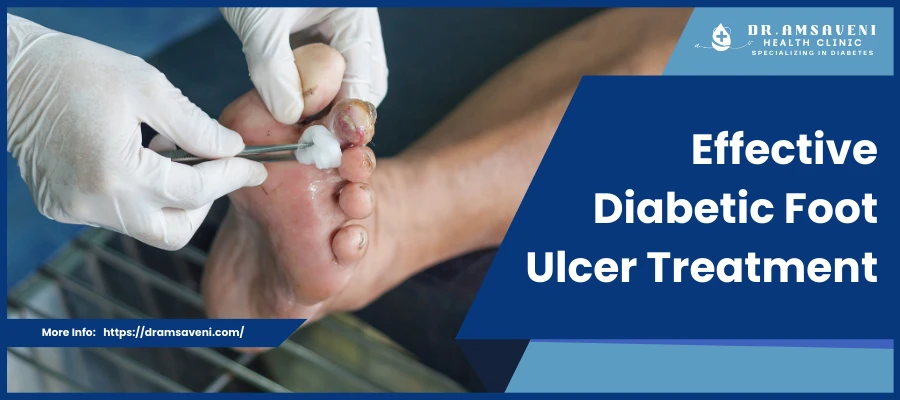Caring for Diabetic Foot Ulcer: A Friendly Guide
Millions around the world are affected by diabetic foot ulcers (DFUs), a serious complication of diabetes. Effective treatment of diabetic foot ulcers is essential to prevent infections, amputations, and other serious issues. Here, evidence-based strategies for managing diabetic foot ulcers will be explored, with a focus on biological principles and best practices to ensure optimal healing.
Understanding Diabetic Foot Ulcer
Diabetic foot ulcers, which are open sores or wounds on the foot, are primarily caused by neuropathy, poor peripheral circulation, and pressure points. The conditions are often worsened by uncontrolled hyperglycemia, leading to tissue breakdown. The stages of diabetic foot ulcers range from minor surface wounds to deeper, more serious infections that require extensive care. Understanding the diabetic foot ulcer stages is crucial for effective treatment.
Diagnosis of Diabetic Foot Ulcer
A comprehensive clinical evaluation by a healthcare professional is critical for the diagnosis of diabetic wounds. This may include:
- Visual Inspection: The ulcer’s size, depth, and surrounding tissue are assessed to diagnose the diabetic foot ulcer accurately.
- Assessment of Foot Pulses: Blood flow to the affected area is evaluated to understand the impact on the diabetic foot ulcer.
- Sensory Testing: Tactile sensation in the feet is assessed using monofilament tests to help diagnose diabetic wound.
- Imaging and Laboratory Tests: X-rays can help identify potential underlying osteomyelitis (bone infection), while blood tests monitor glycemic levels and rule out systemic infections that may affect the diabetic foot ulcer. Accurate diagnosis of diabetic foot ulcer stages aids in selecting the most effective healing method.
Evidence-Based Treatment Options for Wounds
Effective healing methods for diabetic Wounds include various strategies:
- Debridement: Necrotic tissue is removed to facilitate healing. This can be done surgically by specialists or autolytically using moisture-retentive dressings for the diabetic foot ulcer.
- Dressings and Bandages: The appropriate dressing is selected to create an optimal healing environment for the diabetic foot ulcer. Options include hydrocolloid dressings that maintain a moist environment and alginate dressings that are highly absorbent, designed for exudative diabetic foot ulcer. Proper diabetic foot ulcer treatment involves selecting the best dressing.
- Infection Control: Systemic antibiotics are critical when an infection is present in a diabetic foot ulcer. Cultures from the diabetic foot ulcer can guide the selection of appropriate antimicrobial agents. Topical agents like silver sulfadiazine or honey-based dressings can manage local infections effectively. This approach is an effective healing method.
Offloading Pressure for Diabetic Foot Ulcer Healing
Implementing special footwear or orthotic devices helps redistribute pressure away from the diabetic foot ulcer, aiding healing. Offloading devices such as total contact casts or removable walkers play a significant role in alleviating pressure on diabetic foot ulcers, fostering a conducive environment for recovery. Proper diabetic foot ulcer treatment includes managing pressure effectively.
Nutritional Support for Diabetic Foot Ulcers
Proper nutritional support is foundational for wound healing, including the healing of diabetic foot ulcers. Key nutrients to focus on include protein for cellular repair and tissue regeneration, vitamin C for collagen synthesis and enhanced immune response, and zinc for immune function and wound healing. Nutritional support is an effective healing method for diabetic foot ulcers.
Diabetes Management to Support Diabetic Foot Ulcer Healing
Managing blood glucose levels effectively is essential for overall health and the healing process in individuals with diabetes and diabetic foot ulcers. A balanced diet rich in whole foods, including plenty of non-starchy vegetables, whole grains, lean proteins, and healthy fats, is recommended for those managing diabetic wounds.. Regular physical activity, such as walking, cycling, or yoga, can enhance insulin sensitivity and aid in weight management, which benefits diabetic foot ulcers. Hydration with water and herbal teas is crucial, along with mindfulness practices like meditation and deep breathing to reduce stress, which positively impacts blood sugar levels and the healing of diabetic wounds. Consistent monitoring of blood glucose levels enables informed choices and adjustments in diet and lifestyle, fostering a holistic approach to diabetes management and diabetic foot ulcer care. Effective diabetic foot ulcer treatment involves managing diabetes well.
Patient Education and Self-Care for Diabetic Foot Ulcers
Empowering patients with knowledge of daily foot care habits can significantly decrease the risk of diabetic foot ulcer formation. This includes regular foot inspections to catch early signs of diabetic foot ulcers, proper hygiene practices, and moisturizing dry skin to prevent diabetic foot ulcers. Encouraging smoking cessation is also essential, as it can enhance peripheral circulation and overall healing efficacy, benefiting diabetic foot ulcers.
Monitoring and Follow-Up for Diabetic Foot Ulcers
Patients with a history of diabetic foot ulcers should engage in regular follow-up visits to monitor healing progress and preempt potential recurrences of diabetic foot ulcers. Utilizing telemedicine platforms for regular evaluations can bolster patient compliance and improve overall treatment outcomes for diabetic foot ulcers. Effective monitoring is part of diabetic foot ulcer treatment.
Conclusion
Managing diabetic wounds requires a multidisciplinary approach, integrating wound care, infection control, nutritional support, and patient education. By adhering to evidence-based practices, healthcare providers can significantly enhance outcomes for patients facing this debilitating complication. Understanding wound stages and adopting the right effective healing methods are essential for successful management.





